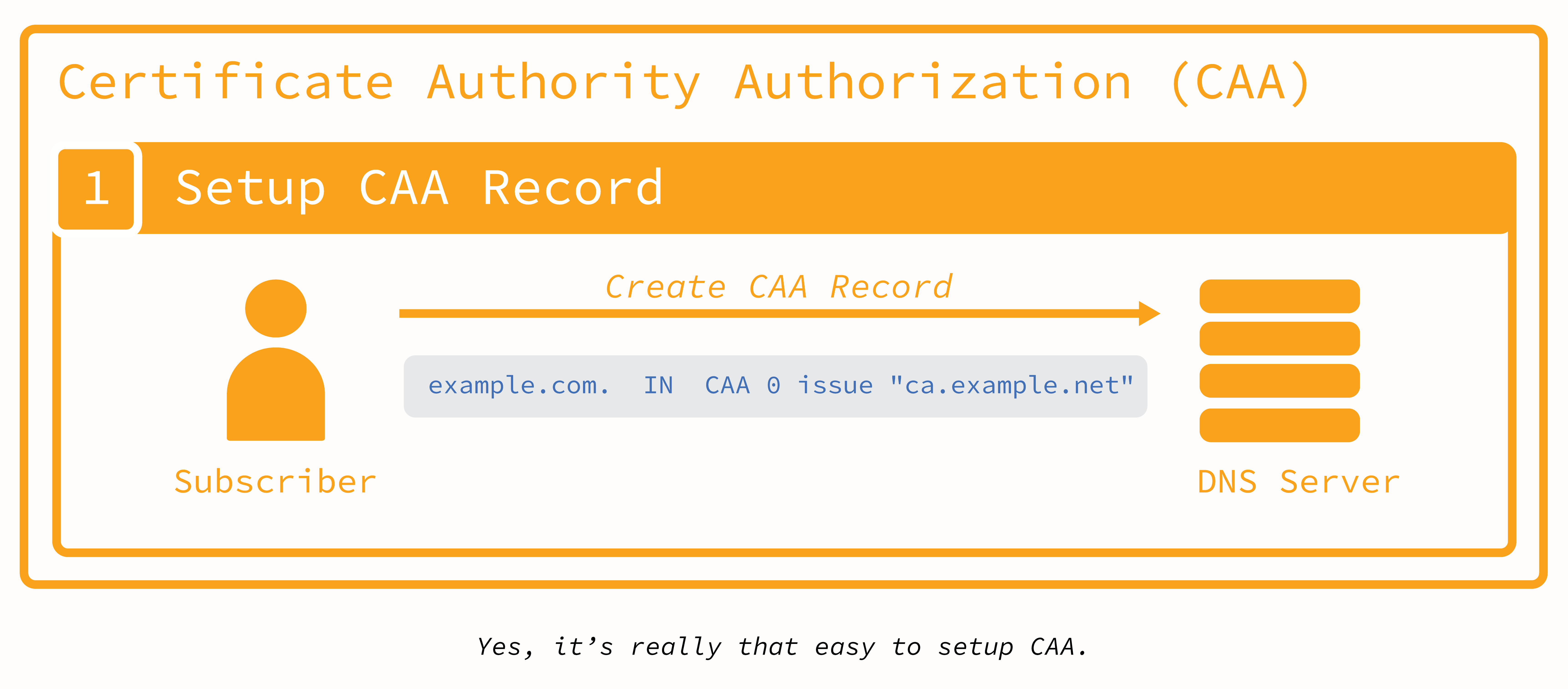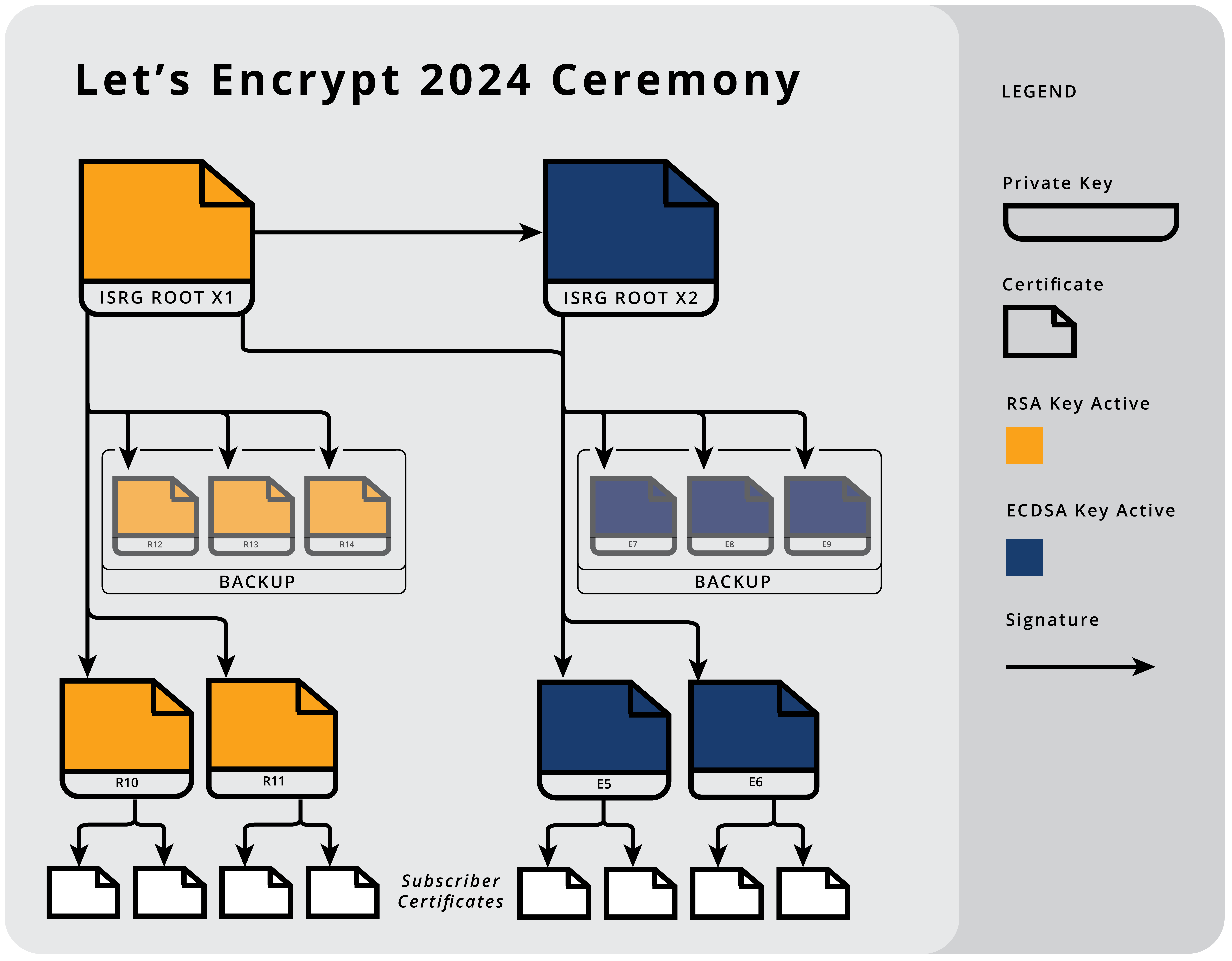Increase your security governance with CAA
According to Cloudflare’s Merkle Town, 257,036 certificates are issued every hour. We at Let’s Encrypt are issuing close to 70% of those certs. Being a Certificate Authority that operates as a nonprofit for the public’s benefit means we are constantly considering how we can improve our Subscribers' experience and security. One simple innovation to do just that is by using CAA (Certificate Authority Authorization), and two CAA extensions for Account and Method Binding. What is CAA? CAA is a type of DNS record that allows site owners to specify which Certificate Authorities are allowed to issue certificates containing their domain names. Using CAA is a proactive way to ensure that your domain(s) and subdomain(s) are under your control—you’re able to add a layer of security to your DNS governance. (By contrast, Certificate Transparency (CT) logs are a reactive way to monitor your DNS governance—by publicly publishing certificates issued to domains, Subscribers can verify that their domain(s) are using the intended CA(s).) We think CAA is important for every Subscriber, but it’s all the more important if you’re handling TLS at scale. This is particularly true if a team or multiple teams have access to your integration. Account and Method Binding is another layer of CAA that can improve your security even further. Method binding allows Subscribers to limit the sets of domain control validation methods—DNS-01, HTTP-01, or TLS-ALPN-01— which can be used to demonstrate control over their domain. Account binding allows a Subscriber to limit issuance to a specific ACME account. For further technical details, review our community post or take a look at RFC 8657. CAA Adoption Famedly, a German healthcare company, set up CAA as part of updating their overall ACME setup. In hearing more about why they chose to turn on CAA now, the answer was simple: because it was easy to do and low hanging fruit to enhance their security. “The biggest benefit of using CAA along with account and method binding is closing the DV loophole,” said Jan Christian Grünhage, Famedly’s Head of Infrastructure. “By using DNSSEC with DNS-01 challenges, we’ve got cryptographic signatures all the way through the stack.” The team at Famedly set up CAA over the course of a few days. “The larger project was to transition our issuance to a single ACME account ID, so adopting CAA as part of that work only added marginal effort,” remarked Jan. “The added security benefit was absolutely worth the effort.” Getting started with CAA If you manage TLS at scale, consider adopting CAA and Account and Method Binding. To get started, review our documentation, RFC 8659 and RFC 8657, and check out the community forum for more from Subscribers who’ve set up or are using CAA. As with anything with DNS, there are some potential hiccups to avoid. The most important to highlight is that CAA will always respect the CAA record closest to the domain name it is issuing a certificate for. For more on this, check out this section of the CAA documentation. You’ll also want to ensure that your DNS provider supports setting CAA records. Thanks to Famedly We’re grateful for Famedly taking the time to share with us more about their experience in setting up CAA. What’s more, Famedly financially supported ISRG this year as part of our tenth anniversary campaign. As a project of the Internet Security Research Group (ISRG), 100% of the funding for Let’s Encrypt comes from contributions from our community of users and supporters. We depend on their support in order to provide our public benefit services. If your company or organization would like to sponsor Let’s Encrypt, please email us at sponsor@letsencrypt.org. If you or your organization can support us with a donation of any size, we ask that you consider a contribution.

According to Cloudflare’s Merkle Town, 257,036 certificates are issued every hour. We at Let’s Encrypt are issuing close to 70% of those certs. Being a Certificate Authority that operates as a nonprofit for the public’s benefit means we are constantly considering how we can improve our Subscribers' experience and security. One simple innovation to do just that is by using CAA (Certificate Authority Authorization), and two CAA extensions for Account and Method Binding.
What is CAA?
CAA is a type of DNS record that allows site owners to specify which Certificate Authorities are allowed to issue certificates containing their domain names. Using CAA is a proactive way to ensure that your domain(s) and subdomain(s) are under your control—you’re able to add a layer of security to your DNS governance. (By contrast, Certificate Transparency (CT) logs are a reactive way to monitor your DNS governance—by publicly publishing certificates issued to domains, Subscribers can verify that their domain(s) are using the intended CA(s).)

We think CAA is important for every Subscriber, but it’s all the more important if you’re handling TLS at scale. This is particularly true if a team or multiple teams have access to your integration.
Account and Method Binding is another layer of CAA that can improve your security even further. Method binding allows Subscribers to limit the sets of domain control validation methods—DNS-01, HTTP-01, or TLS-ALPN-01— which can be used to demonstrate control over their domain. Account binding allows a Subscriber to limit issuance to a specific ACME account. For further technical details, review our community post or take a look at RFC 8657.
CAA Adoption
Famedly, a German healthcare company, set up CAA as part of updating their overall ACME setup. In hearing more about why they chose to turn on CAA now, the answer was simple: because it was easy to do and low hanging fruit to enhance their security.
“The biggest benefit of using CAA along with account and method binding is closing the DV loophole,” said Jan Christian Grünhage, Famedly’s Head of Infrastructure. “By using DNSSEC with DNS-01 challenges, we’ve got cryptographic signatures all the way through the stack.”
The team at Famedly set up CAA over the course of a few days. “The larger project was to transition our issuance to a single ACME account ID, so adopting CAA as part of that work only added marginal effort,” remarked Jan. “The added security benefit was absolutely worth the effort.”
Getting started with CAA
If you manage TLS at scale, consider adopting CAA and Account and Method Binding. To get started, review our documentation, RFC 8659 and RFC 8657, and check out the community forum for more from Subscribers who’ve set up or are using CAA.
As with anything with DNS, there are some potential hiccups to avoid. The most important to highlight is that CAA will always respect the CAA record closest to the domain name it is issuing a certificate for. For more on this, check out this section of the CAA documentation. You’ll also want to ensure that your DNS provider supports setting CAA records.
Thanks to Famedly
We’re grateful for Famedly taking the time to share with us more about their experience in setting up CAA. What’s more, Famedly financially supported ISRG this year as part of our tenth anniversary campaign.
As a project of the Internet Security Research Group (ISRG), 100% of the funding for Let’s Encrypt comes from contributions from our community of users and supporters. We depend on their support in order to provide our public benefit services. If your company or organization would like to sponsor Let’s Encrypt, please email us at sponsor@letsencrypt.org. If you or your organization can support us with a donation of any size, we ask that you consider a contribution.





































